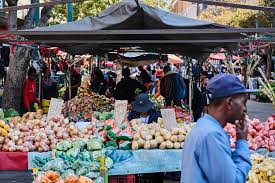South Africa’s headline inflation rate remained unchanged at 2.8% year-on-year in May 2025, according to data released on Wednesday by Statistics South Africa. The figure matches the April reading and was in line with forecasts by economic analysts.
This marks the tenth consecutive month that inflation has stayed below the midpoint of the South African Reserve Bank’s (SARB) target range of 3% to 6%, strengthening expectations for further monetary policy easing in the coming months.
The central bank has responded to the cooling inflation trend by cutting interest rates in four of its last five policy meetings. Most recently, in May, the SARB lowered its main lending rate by 25 basis points, bringing it down to 7.25%.
Analysts believe this consistent downward trend in inflation gives the SARB room to continue with its accommodative stance, especially as it tries to support economic recovery in the face of ongoing structural challenges and weak consumer demand.
In a statement accompanying its last rate decision, the SARB revised down its inflation and GDP growth projections for both 2025 and 2026. The central bank also repeated its long-standing preference for a lower inflation target, signalling its intent to keep inflation within the lower end of the 3%-6% band.
On a month-to-month basis, consumer inflation was recorded at 0.2% in May, slightly down from the 0.3% increase seen in April. This slight decrease shows continued stability in consumer prices, particularly in food, transport, and energy-related categories.
Financial experts say the steady inflation trend is good news for households, especially given the high cost of living and unemployment levels in the country. Lower inflation means the cost of goods and services is not rising as fast, helping South Africans stretch their income further.
Speaking on the data, senior economist Thabiso Ndlovu noted:
“The latest inflation figures are not just in line with expectations, they also give the SARB more confidence to cut rates again, if needed. This could boost household spending and stimulate economic activity.”
He added that inflation has remained under control partly due to easing global fuel prices, stable food supply, and a relatively strong rand in recent months.
With inflation now firmly below the SARB’s midpoint, attention will shift to the next monetary policy committee (MPC) meeting. Some market watchers believe the central bank could deliver another 25-basis-point cut if domestic inflation remains stable and external risks such as geopolitical tensions or currency volatility are managed.
At the same time, economic observers caution that while inflation remains low, growth remains fragile. South Africa continues to struggle with structural issues like high unemployment, load-shedding (power cuts), and sluggish investment levels.
According to the latest SARB forecasts, economic growth is expected to remain under 1.5% this year. That makes the case for supporting demand through lower borrowing costs even more compelling.
The current stable inflation trend is welcome news for businesses and investors as well. A low and predictable inflation environment often encourages long-term investment, especially in sectors like manufacturing, retail, and housing.
Retailers and banks are also closely watching these developments. Lower interest rates typically boost borrowing and consumer spending, which could help lift sales and credit activity in the second half of the year.
As of now, South Africans can expect a stable pricing environment, with cautious optimism about further relief from the SARB in the form of additional rate cuts.
